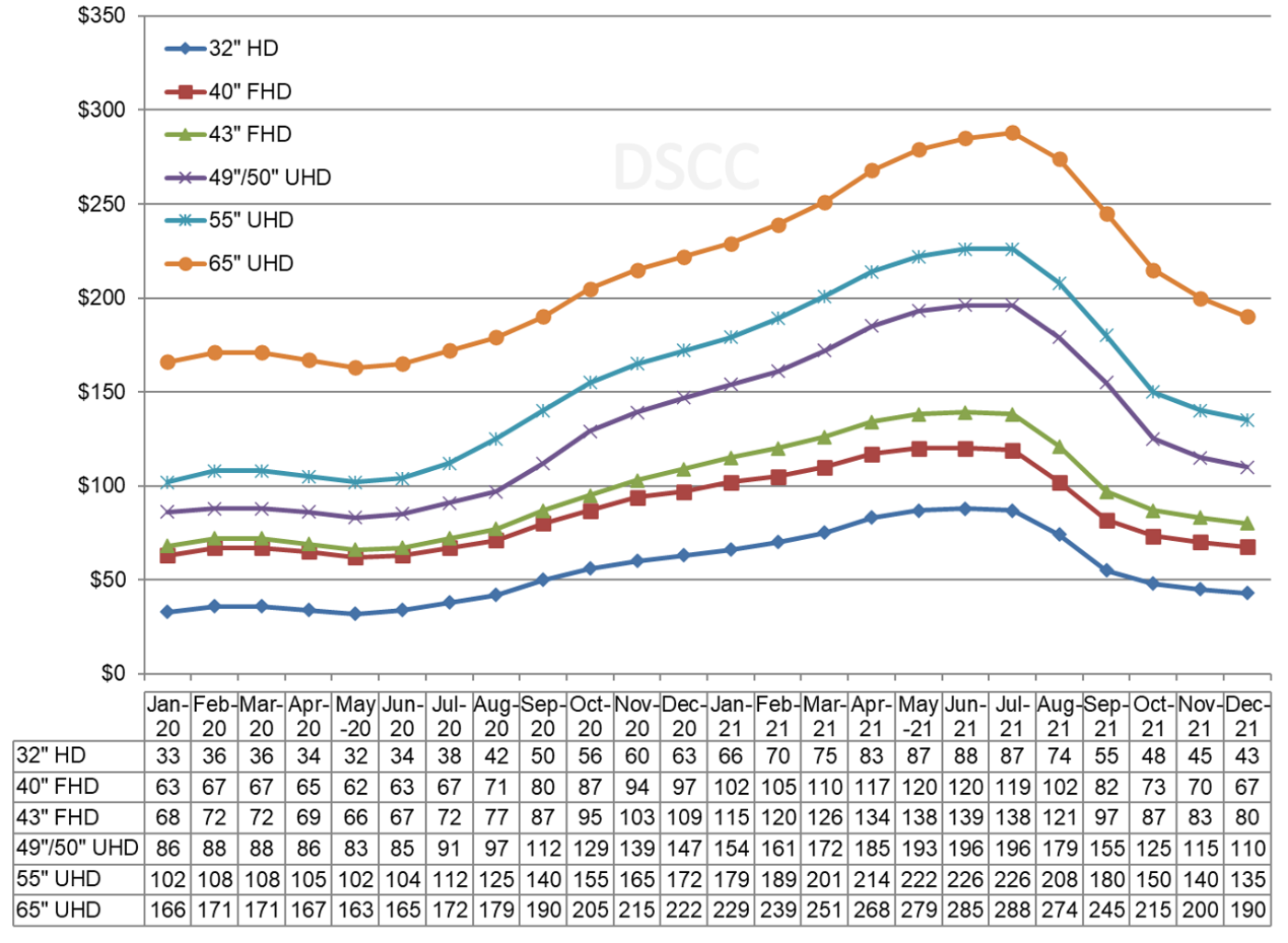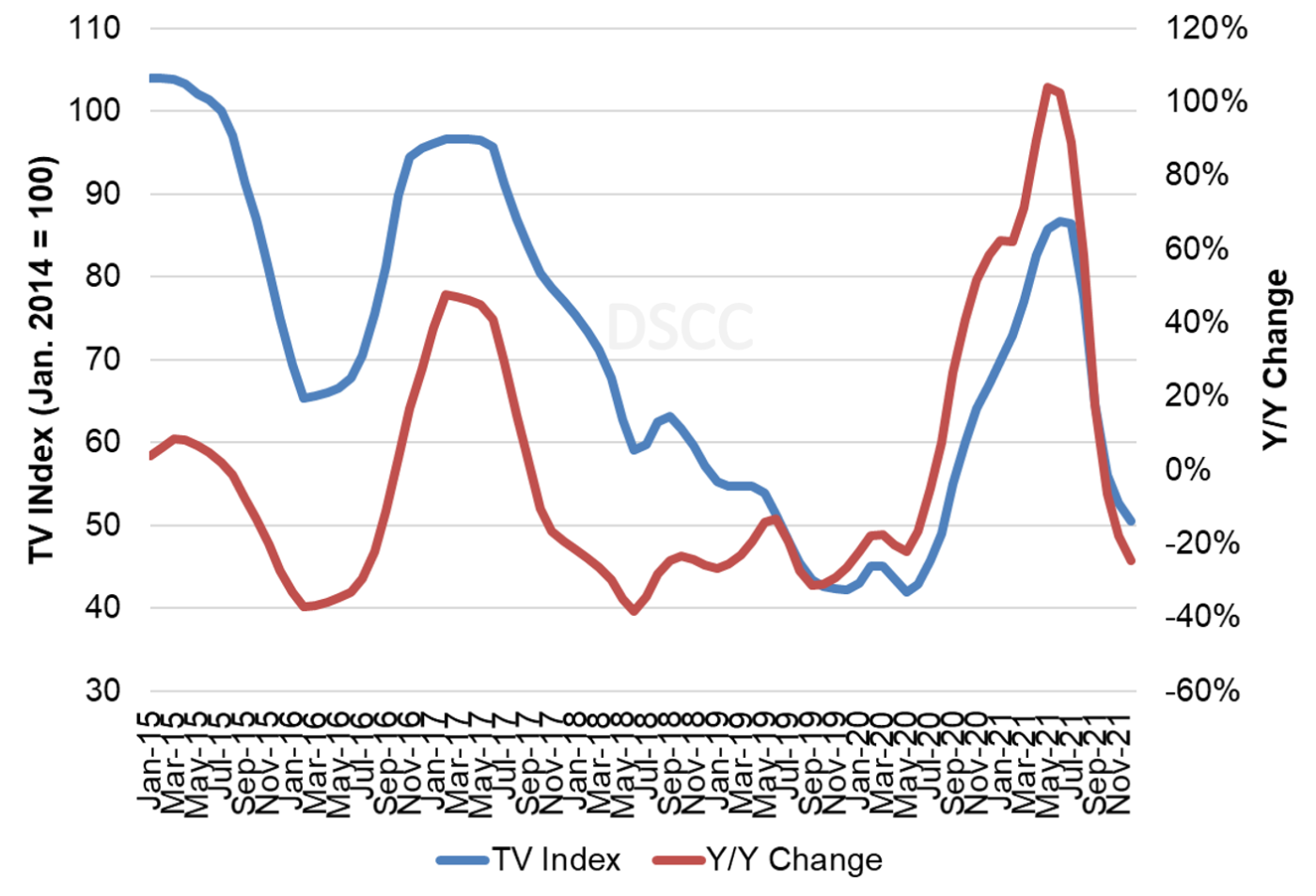国内お問い合わせ窓口
info@displaysupplychain.co.jp
FOR IMMEDIATE RELEASE: 10/04/2021
LCD TV Panel Prices in Free-Fall in September
Bob O'Brien, Co-Founder, Principal AnalystAnn Arbor, MI USA -
The latest turn of the Crystal Cycle has been characterized by several unprecedented developments: the largest price increase from trough to peak, the longest period of rising prices and the first time TV prices increased. Now we can add another item to the list: the largest price drop in a month. LCD TV panel prices fell in September at their fastest rate ever on a percentage basis and have now lost more than half the gains that they achieved in the long up-cycle from May 2020 to June 2021.
In our summer updates, we referred to a series of events that suggested slowing demand and increasing supply, and nothing in September disrupted this outlook. The increasing panel prices have led to an unprecedented increase in TV prices in the US, which will hinder demand. After nearly a year where component shortages and logistics problems had brands and retailers scurrying to find enough supply, the brands and retailers have caught up. For developed regions, the opening of economies allows consumer spending to shift back to services, and emerging economies are still struggling with COVID and suffering an economic slowdown.
The first chart here highlights our latest TV panel price update, showing both the biggest price increases in the history of the flat panel display industry, from May 2020 to June/July 2021 and then the fastest price decreases in the industry in September 2021. While the September 2021 prices are higher than those of September 2020, they are lower than the prices of October 2020. The price increases of nine months (Oct 2020 – June 2021) have been reversed in only three.
LCD TV Panel Prices January 2020 - December 2021
In September, prices for all TV panel sizes fell, with the biggest percentage declines occurring for the smallest sizes. The average price decline in September across the seven sizes we track was 15.8%, and the 32” panel price declined more than 25%.
Looking at the third quarter of 2021, the average price decline is less severe than the decline at the end of the quarter would suggest. Prices declined for all panel sizes, but the biggest declines occurred for the smaller sizes. The largest size 75” LCD TV panel prices averaged over the third quarter declined by only 1.6% compared to the second quarter, but price declines for 32”, 40” and 43” exceeded 10% Q/Q.
The average for the third quarter understates the decline. Compared to prices in June 2021, all sizes of LCD TV panels have seen double-digit % declines except for 75”, which declined by “only” 9.6%. Prices of 32”, 40” and 43” panels have all fallen more than 30% from their peak.
Although we expect panel price declines to come more slowly in Q4, much of the damage has been done. Even if prices managed to stop falling and stay at September levels, the average price in Q4 would be 14% lower than the average price in Q3. With the additional price declines that we expect in Q4, we expect prices to decline by 29%, with the Q/Q price declines ranging from 19% to 37%.
As we look at pricing on an area basis, we have noted that smaller screen TVs are the most commoditized: prices for 32” panels fall the fastest during a period of oversupply and rise the fastest during a period of shortage. We see that pattern repeating again with oversupply. At the peak of the recent upswing, the smallest TV panels sold with an area premium, but the shift to oversupply has caused that pattern to flip, as shown in the next chart.
Monthly Area Prices per Square Meter for TV Panels, January 2018 - December 2021
Whereas in May 2020, 75” panels sold at an area premium of $77 per square meter higher than the 32” panel price, as of July 2021, they were selling at a $56 discount on an area basis. This means that those Gen 10.5 fabs could earn higher revenues from making 32” panels than from 75” panels. The pattern for 65” is even more severe, and in June, 65” was selling at a $67 per square meter discount (alternately, a 21% area discount) compared to 32”.
In the second half of 2021, though, we are seeing 32” TV panel prices falling fastest, with a 37% decline between June and September 2021, while 75” TV panel prices have fallen only 9.6% from their mid-year peak. As of September, 32” panel prices are now at a 14% discount compared to 75”. Strangely in this period of transition, in September, the highest priced panels on an area basis were 49”/50”, priced 3% higher than 75”.
The last chart here shows our TV price index, set to 100 for prices in January 2014, and the Y/Y change of LCD TV panel prices. Our index increased from its all-time low of 42 in May 2020 to 87 in June 2021, but prices have already fallen to 65 in September. We now expect the index to decline to 50 at year-end, 25% lower than in December 2020, but still 20% higher than in May 2020. The Y/Y increase surpassed 100% in May and June 2021 but fell to +18% in September and is expected to go negative in October.
TV Panel Price Index and Y/Y Change, January 2015 - December 2021
Last week, an article in Digitimes quoted Innolux President James Yang saying that LCD panel prices are expected to fall at a slower pace in the fourth quarter of 2021 and become relatively stable in the first quarter of 2022. Our forecast largely agrees with this outlook. Yang points out that power restrictions in China are likely to affect supply chains, leading to upward pressure on prices. Although our analysis of the power restrictions shows that panel makers are not directly affected (see separate article in this issue), we expect that some materials and components are likely to be constrained.
With the COVID-19 demand surge assisted by shortages in glass and DDICs, we saw a historic year of increases in panel prices, and panel makers post their most profitable quarter ever in the second quarter of 2021. The price declines in Q3 undoubtedly led to lower revenues and profit margins for flat panel display makers, but prices at their current levels remain substantially higher than costs. Even price declines in Q4 will sustain some profitability for LCD panel makers, who continue to be in line for record full-year profits.
About Counterpoint
https://www.displaysupplychain.co.jp/about
[一般のお客様:本記事の出典調査レポートのお引き合い]
上記「国内お問い合わせ窓口」にて承ります。会社名・部署名・お名前、および対象レポート名またはブログタイトルをお書き添えの上、メール送信をお願い申し上げます。和文概要資料、商品サンプル、国内販売価格を返信させていただきます。
[報道関係者様:本記事の日本語解説&データ入手のご要望]
上記「国内お問い合わせ窓口」にて承ります。媒体名・お名前・ご要望内容、および必要回答日時をお書き添えの上、メール送信をお願い申し上げます。記者様の締切時刻までに、国内アナリストが最大限・迅速にサポートさせていただきます。


